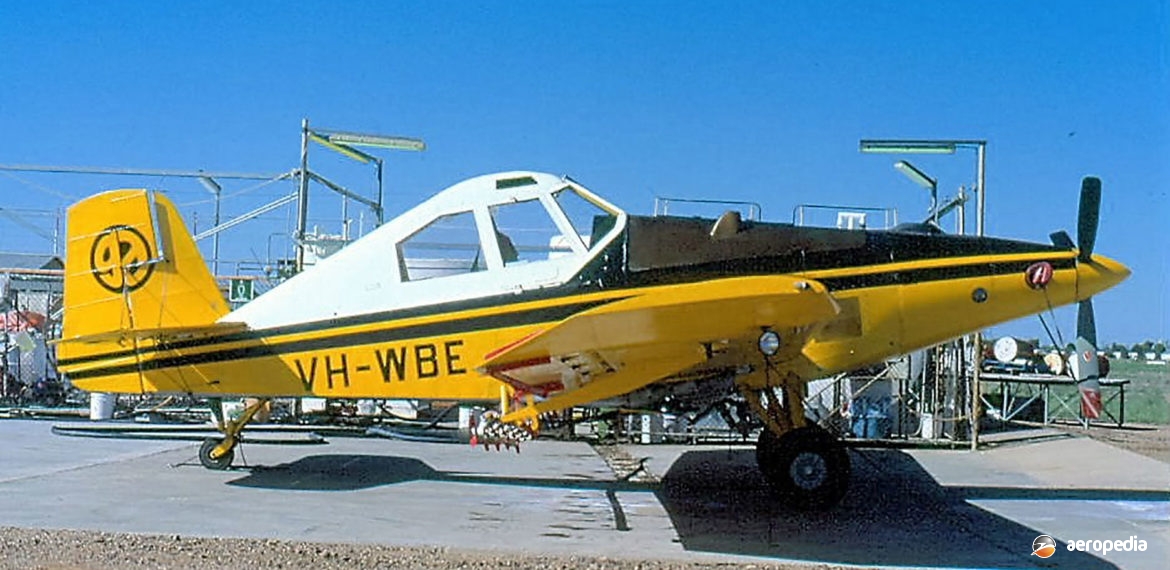Photograph:
Ayres S-2R-T15 Turbo Thrush VH-WBE (c/n T15-020DC) at Moree, NSW (David C Eyre)
Country of origin:
United States of America
Description:
Single-seat agricultural monoplane
Power Plant:
One 560 kw (750 shp) Pratt & Whitney PT6A-34 agro-turbine
Specifications:
- Wingspan: 13.543 m (44 ft 5 in)
- Length: 10.06 m (33 ft)
- Height: 2.79 m (9 ft 2 in)
- Wing area: 30.34 m² (326.6 sq ft)
- Max speed at sea level: 356 km/h (149 mph)
- Cruising speed at 50% power: 241 km/h (150 mph)
- Stalling speed flaps down: 92 km/h (57 mph)
- Max rate of climb at sea level: 533 m/min (1,750 ft/min)
- Service ceiling: 7,620 m (25,000 ft)
- Ferry range at 40% power: 724 km (450 miles)
- Empty weight: 1,633 kg (3,600 lb)
- Loaded weight: 2,722 kg (6,000 lb)
History:
Fred Ayres, an agricultural aircraft operator in the USA, commenced production in 1979 of a version of the Thrush Commander powered by a Pratt & Whitney PT6 turboprop. This became known as the Ayres Turbo Thrush. With help from Rockwell International, manufacturers at the time of the Thrush Commander, Mr Ayres developed his design to a stage where he commenced production using Thrush Commander 600 and 800 airframes, carrying out about 45 alterations in the conversion. Eventually Rockwell sold its agricultural division at Albany, Georgia, to Mr Ayres, and subsequently all production was carried out by the Ayres concern.
Structure was of all-metal. The fuselage skin could be easily removed for internal cleaning and inspection of the flying-control cables, etc. The fibreglass hopper was positioned close to the centre of gravity to minimise pitch changes as the load varied. It had a capacity of 3.75 m³ (53 cub ft) or 1,514 litres (333 Imp gals).
Due to the world fuel crisis in the 1980s, and the ready availability of turbine fuel for military and civil jet aircraft, turboprop-powered agricultural aircraft became very popular, despite the high initial cost, with a range of operators. Also, the comparatively long time between overhauls of 3,500 hours for the PT6 (five years flying with some agricultural operators) influenced the increasing sales of the turbine powered Turbo Thrush.
The first Turbo Thrush arrived in Australia at the end of 1979, and at that time three variants were available: S-2R-T11 with a 373 kw (500 shp) Pratt & Whitney Canada PT6A-11AG turboprop and a standard 1,514 litre (333 Imp gal) chemical hopper; S-2R-T15 with a 507 kw (680 shp) PT6A-15AG turboprop and the 1,514 litre (333 Imp gal) hopper as standard but with a 1,930 litre (424 Imp gal) hopper as an option; and S-2R-T34 with a 560 kw (750 shp) PT6A-34AG turboprop with either hopper. In each case a Hartzell three-blade constant-speed fully-feathering and reversible-pitch metal propeller was installed.
The prototype of the S-2R flew on 9 September 1975. It was claimed that the advantage of the S-2R over the Ayres Thrush 600, which was fitted with a 448 kw (600 hp) Pratt & Whitney R-1340 radial engine, was an improved take-off and climb performance, improved short landing capability, a 454 kg (1,000 lb) increase in payload due to reduced power plant weight, and an ability to operate on turbine fuel, avgas, or diesel fuel.
Development of the series has continued over the years and, as noted elsewhere, more than fifty examples of the series have been registered in this region.
In March 2000 the Ayres Corporation certificated the 660 Turbo Thrush. The first three aircraft of this new model had 783 kw (1,050 shp) PT6A-60AG engines, but the fourth aircraft had available as an option the 918 kw (1,230 shp) PT6A-65AG engine. The new model had an empty weight of 2,336 kg (5,150 lb) and a loaded weight of 5,670 kg (12,500 lb).

